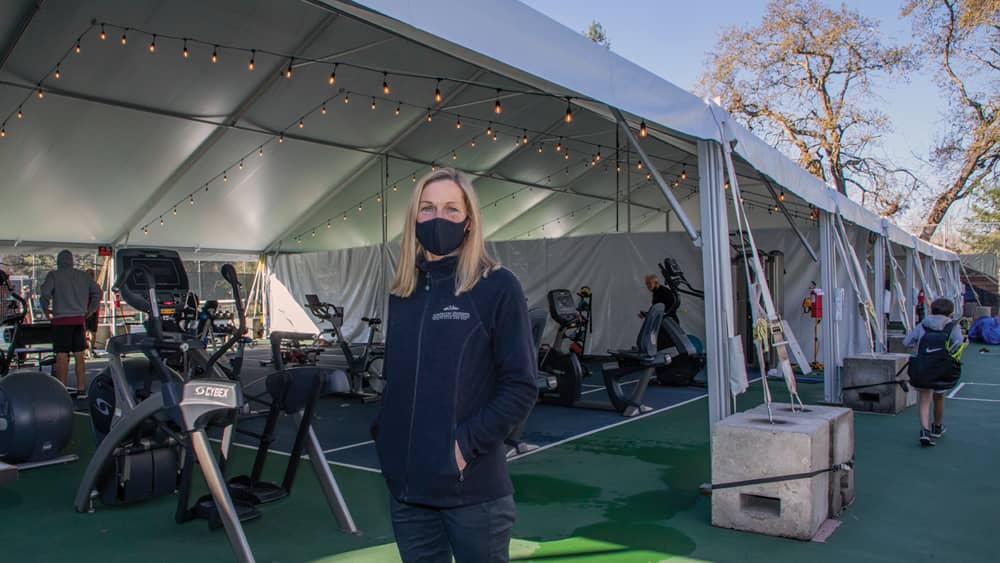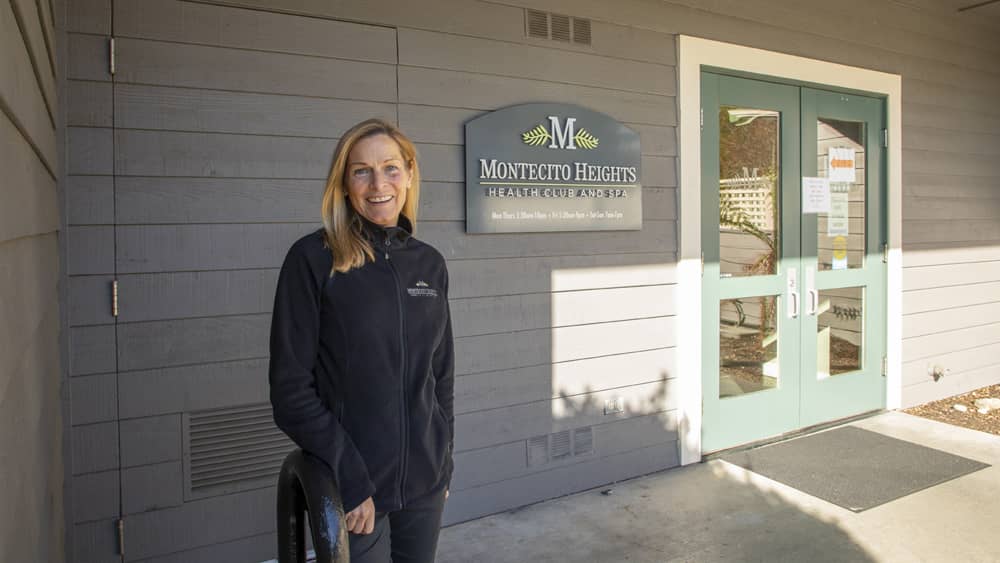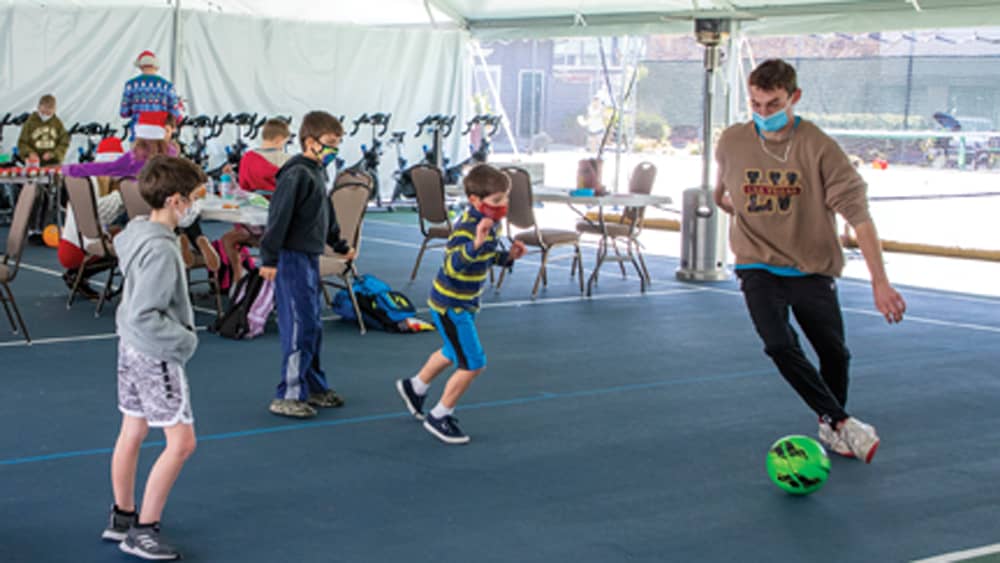
Catherine DuBay and her crew at Montecito Heights Health Club and Spa in Santa Rosa are gearing up for an arduous task. The staff will move a massive amount of weights and workout equipment—free weights, weighted resistance machines, exercise bikes—that wasn’t built to be moved that often or at all. It’s part of the ongoing process of adapting to COVID-19 restrictions, meant to stop the spread of coronavirus.
DuBay, the club’s general manager, says her staff had to take the drastic measure of moving the equipment from the 31-year-old establishment’s second floor down to the tennis court to survive the unprecedented limitations to running a gym during a pandemic. Chiefly, health measures state that business should be conducted outside whenever feasible, with the virus less likely to spread in an open-air environment.
“It was brutal,” DuBay says of the latest herculean effort by her and her staff. After the initial move outside, the equipment sat under two rented tents; with the pandemic still ongoing, DuBay recently purchased the gym’s own portable structure, which required the heavy machines and weights to be moved yet again. Thanks to an unthinkable effort from DuBay and her staff, Montecito Heights Health Club has been open outdoors since July of last year. “Weight room equipment is not light. But our staff has been unbelievable and more than willing to help. We’re getting it done, but it is not easy.”

Staying in business during a pandemic
Gyms across the country have been hard hit by the coronavirus, and in California, a state that’s adopted relatively strict shelter-in-place measures, non-essential businesses like gyms and fitness centers have suffered economically, while The New York Times reports gym closures had an overall negative effect on health at a time when it’s needed most.
California’s “Blueprint for a Safer Economy,” framed as a reopening plan for the state amid the pandemic, enforces restrictions on behaviors and businesses based on a color-coded tier system determined by its test positivity rate or adjusted cases; if the county in question has a positivity rate of 8-percent, or an adjusted case count of seven active cases per 100,000 residents, the county will fall in the “widespread,” purple-tier designation that requires most indoor business operations to close.
Although its total confirmed case and COVID-19-related death counts have been relatively low—12,319 confirmed cases with 157 deaths at the end of November, according to the Los Angeles Times—Sonoma County hasn’t brought its caseload below the seven cases per 100,000 threshold required to go down a tier, which would allow a wider reopening of businesses such as gyms, restaurants, and wineries, in addition to places of worship or any other large, indoor gatherings such as weddings and receptions.

Prior to the surge during the holidays, the state labeled Sonoma County as the only Bay Area county in the purple tier, which local officials attributed partly to the inability to observe self-quarantine for those evacuated during the fires. As of November, however, Marin County was the only Bay Area county and one of the few in the state to escape the purple tier.
The third COVID-19 surge experienced locally and across the nation this fall does not bode well for the resumption of indoor activities like those previously offered at Montecito Heights. So, like other gym owners in Sonoma County—a long-time purple tier county forced to comply with California’s strictest COVID-19 measures—Montecito Heights had to adapt.
A new approach
The gym closed down entirely during the first shutdown, which DuBay, like many others, thought would only last a couple of weeks. As shelter-in-place measures continued, Montecito Heights—which generally offers 100-plus classes a week, child care, access to hot tubs, steam rooms and saunas in the locker rooms, as well as tennis courts and two heated lap pools—began looking to virtual classes as a way to provide services to members. According to DuBay, she turned to other local gym owners, with whom she participates in an industry email chain, for ideas, and the club invested in purchasing equipment necessary to offer Zoom classes.
Things started to look better in June, by which time Montecito Heights could reopen its pool and tennis courts in addition to the online classes offered. However, the worsening coronavirus surge in early summer prompted another round of strict shutdown measures across the state.
Memberships have also taken a hit, with many members placing their arrangement on hold by paying a small fee until business as usual resumes. Montecito Heights didn’t charge its members for part of the initial lockdown, but after offering access to outdoor and virtual services, the gym began charging 50 percent of monthly dues. With more and more services provided virtually or in person, however, DuBay resumed charging the full fee in August. Still, that doesn’t make up for income lost from members who cancelled or went on leave because they don’t want to risk of contracting or spreading the virus, despite the abundant precautions.
“Our membership has dropped pretty dramatically,” says DuBay. “ We gave them a choice. We didn’t bill anybody at all in April; in May we billed 50 percent, and then we went back full in August. We’ve had some people who went on leave, and we had a slew of people cancel.”
The reduction in gym membership or a lack of full-access is perilous in times like these, when exercise as a tool for overall mental and physical health has never been more important.

Health and immunity
James Schieberl, M.D., a family practitioner at Kaiser Permanente’s Santa Rosa campus, emphasizes that exercise is critical to ensuring overall health, proper immune functioning and resistance to infections.
“I can’t express enough how important exercise is in preventative health, particularly during difficult times,” Schieberl says.
According to Schieberl, there haven’t been enough studies to definitively conclude that exercise is helpful in preventing the risk of severe COVID-19 infections; but maintaining health can help combat increased risk factors for coronavirus-related complications, such as obesity and diabetes. Furthermore, exercise is an important tool for improving mental health.

Schieberl recommends 30 minutes of exercise a day, but admits that difficulty in maintaining regular exercise routines has made it difficult for many of his patients to exercise as they did pre-pandemic. Schieberl credits this as one of many factors potentially contributing to what he called a “definite correlation to the pandemic and some weight gain” among his patients. Weight gain can contribute to other negative health effects, such as increased blood pressure and diabetic conditions.
While Schieberl praises exercise as one of three key components to overall health and a healthy immune system (the other two being proper nutrition and sleep), he also advises exercisers to ensure they observe proper coronavirus safety measures. These measures include wearing a mask, even if just to benefit others, and, of course, observing a proper social distance of six feet.
Some of Schieberl’s patients have had to get creative during the pandemic to maintain some semblance of pre-pandemic fitness regimens. One patient, for example, took his swimming routine from the lap pool to a natural body of water. “I have a patient who is a master swimmer,” Schieberl says. “Even though, technically speaking, you can still get a lane, it’s very difficult. He’s chosen to swim in Lake Sonoma instead.”
For those looking to continue their activity during the pandemic, Schieberl advises not to overthink the situation. Utilizing technology, such as watching workouts on YouTube or engaging with fitness instructors via virtual sessions, is helpful in staying active. Even easier, walking 30 minutes a day can be plenty to gain the benefits of exercise, as well as enjoy some time outdoors. Being outdoors as well as getting exercise can be beneficial to mental health, another aspect of life suffering during the pandemic.
While it’s no secret people are struggling with their mental health during the pandemic, as increased isolation and uncertainty, destruction of normal routines and lack of physical exercise compound on one another, Schieberl cited an overall rise in anxiety among his patients as evidence people need to take their mental health seriously during the pandemic.
Kaiser Permanente also confirmed that incidences of drug and alcohol abuse have been on the rise during the pandemic, an indicator of suffering mental health. If patients can’t exercise or find other ways to assuage mental-health needs on their own, Schieberl urges them to seek support through their medical provider.
Fitness instructor and certified personal trainer Natalie Prunty has had to adapt both her business and personal fitness routine to the pandemic era, and she emphasizes that it’s doable with technology and some compromises to stay fit during the pandemic.
Prunty, who worked in marketing before making the switch to the fitness industry last year, was working as an instructor and personal trainer at Montecito Heights and Energize Hot Yoga for about six months before COVID-19 changed everything. “Business was booming,” Prunty says. “I worked for a local gym and was teaching for a couple of studios. Then COVID hit and everything shut down. Initially, we thought it was gonna be a few weeks. Once we realized this is what’s happening now, we adapted.”
Since then, technology and outdoor workouts have been her bread-and-butter, both personally and with clients. Prunty currently teaches virtual and outdoor classes as well as offering personal training through fitness centers and on her own. “Virtual classes have been really cool. We were all learning how to do this on the fly,” she says.

Prunty understands why people have a hard time prioritizing exercise during the pandemic. Admitting she herself was guilty of slacking on exercise during the start of the pandemic, she says when it became clear things wouldn’t go back to normal immediately, she made some big adjustments. “I definitely had my quarantine phase of watching Tiger King on Netflix and baking cookies during the day. Being a fitness professional, I was pretty down on myself. I definitely had a few weeks where I did nothing. I had that struggle,” Prunty says.
After investing in a home gym and committing more to exercise that doesn’t require equipment, such as hiking and high-intensity interval training (HIIT), Prunty and another trainer within her “quaran-team” bubble, have started making workout videos at a local high school track to demonstrate the kinds of bodyweight exercises that can be utilized during the pandemic.
Prunty, who has launched a fitness website (natalieprunty.com), in addition to starting a fitness-related Instagram page (@natalieprunty.fit), says one of the surprising benefits of coronavirus is her ability to virtually reach geographically-distant clients, something she hopes to further expand with her newly-increased online presence.
She says people who need the accountability can train virtually or find outdoor personal training services, such as the ones she offers at Montecito Heights, where she trains small groups when not teaching classes. Prunty also says that the best exercise is the exercise a person will do—consistent body movement is key, so find exercises that are enjoyable to keep the momentum going.
“It’s a pretty simple equation to get fit,” Prunty says. “To lose weight, you need to be in a calorie deficit. But getting fit is about consistency—and that’s a mental challenge. You can still work out with the gyms closed. You just may have to get a little creative, and this is where a coach can be helpful.”
Kim Kulp, a registered dietician with The Gut Health Connection, is also reaching more clients with virtual sessions. Kulp, who focuses on how diet can affect anxiety and depression, says that both the strain on mental health and the normalization of telehealth services have impacted her business during the pandemic.

Technology has allowed Kulp to help more clients during the pandemic, and she emphasizes that nutrition, hydration, exercise and sleep are key components to overall physical and mental health. She advises clients against reacting to unproven claims that have been tossed around as nutritional remedies to COVID-19, such as Vitamin C and zinc. Similarly, she advises clients not to over-restrict foods, such as dairy and gluten, unless it’s necessary.
Regarding exercise, Kulp says that while many of her clients are sticking to outdoor classes or purchasing indoor workout equipment, others are finding that they can get adequate exercise without spending money. Like Schieberl and Prunty, Kulp says one of the best exercises she can recommend is hiking outdoors. “People are finding that they’re saving money not going to gyms, and there’s a lot they can do that they enjoy without it,” Kulp says.
But many are more than ready to return to their pre-pandemic gym routine. At Montecito Heights, DuBay and her team, about 60 percent of whom have returned, are making their best effort to keep members and employees safe during the pandemic. The club has hired additional cleaning crew members, who sanitize the equipment hourly, and members are asked to sanitize equipment before and after use as well as complete a health screening before each workout. The locker rooms are open for changing only, masks are encouraged when outside unless social distance can be achieved and reservations are required to use the lap pool.
Virtual classes such as yoga and pilates, of which Montecito Heights now offers 10 per week in addition to 40 outdoor classes, have worked partly because of the loyalty gym-goers feel toward instructors, as well as the need for accountability in pursuing fitness goals, part of the reason DuBay thinks her industry isn’t going anywhere.

The newly-reacquired sense of normalcy is a major achievement at a time of so much uncertainty. With multiple vaccines on the way, there may be a wider-spread return to normality in the spring; however, it’s difficult to be certain. And while many gym-goers have had to adapt, with sales of at-home equipment like Peloton bikes exploding in the vacuum created by gym closures, DuBay says there’s a social aspect that’s missing from home workout routines that keep people coming back to the gym and committed to their workout goals. “You have to be very self-motivated [to work out at home]. I think that’s what brings people back and helps them be compliant with exercise [restrictions],” she says, praising her members for understanding.
DuBay also praised her staff for their dedication and sense of humor. Gym equipment certainly wasn’t made to be moved so regularly. The crew continues to perform any task needed, however—along with the entire health industry during this unthinkable time, so customers and friends can enjoy healthy, normal moments during a difficult time for all.
Author
-

Brandon McCapes got his start in journalism covering the North Bay Fires in 2017. Since then he has covered local politics in the North Bay and Sacramento Area, specializing in hard news and local government.
View all posts



